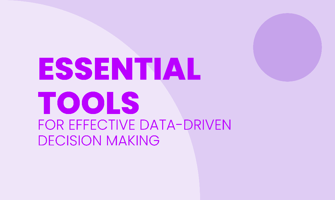Data analysis tools have become indispensable for businesses aiming to stay competitive. They...
Integrating Marketing in Revenue Operations: A Comprehensive Guide
Do you want to increase your business's revenue and profitability? Maybe merging marketing operations with revenue operations is the answer.
SiriusDecisions found that companies combining marketing and sales operations experience a boost in revenue and profit.
In this guide, we'll explain the variances between Marketing Operations and Revenue Operations, how they collaborate, and the advantages they provide. Discover how blending marketing operations in revenue operations can enhance your business's success.
The Role of Marketing in Revenue Operations
Definition of Revenue Operations
Revenue Operations, also known as RevOps, is a strategic approach that integrates and aligns sales, marketing, and customer success departments to enhance customer experience and boost revenue growth.
It focuses on managing processes, systems, and data to ensure consistent and scalable growth across the entire revenue cycle. This unifies operations supporting revenue teams to generate revenue effectively.
Key Responsibilities of Revenue Operations:
Managing the technology stack
Implementing data-driven processes and analytics
Coordinating efforts across multiple teams
Ensuring a seamless revenue cycle
Revenue Operations also emphasizes performance metrics and KPIs to drive accountability and align with business goals. By aligning sales, marketing, and customer success departments, RevOps aims to create a unified team that delivers a seamless and positive customer experience, achieves revenue growth, and improves profitability.
Key Responsibilities in RevOps
A Revenue Operations (RevOps) team has two primary responsibilities:
Driving revenue growth
Improving operational efficiency
They do this by aligning marketing, sales, and service teams to optimize revenue streams. Data management and automation are important for better efficiency and performance.
The team focuses on:
Key performance indicators (KPIs)
Measuring the impact of marketing campaigns
Evaluating data analytics
This helps support a smooth customer journey and drive revenue growth.
RevOps teams enhance lead generation, customer service, and sales enablement through:
Training
Technology enablement
Efficient management of systems and assets
They align departments towards common revenue goals, standardize processes, and create a customer-centric culture to boost customer experience and satisfaction.
Implementing a RevOps strategy helps businesses streamline operations, improve communication between departments, and increase overall revenue growth.
Marketing Operations within RevOps
Marketing's Impact on Revenue Streams
Marketing is important for revenue. It helps create campaigns that engage customers and generate leads. When marketing works with sales and customer service, it ensures a smooth customer experience that brings in more revenue.
To make the most impact on revenue growth, it's important to standardize processes, use technology to automate tasks, and make decisions based on data.
Tracking KPIs and using analytics help understand how well marketing is working and what areas can be better.
Integrating Marketing Efforts with Sales and Service Teams
To make sure customers have a good experience, marketing, sales, and service teams can work together using a Revenue Operations strategy.
This means aligning these departments, breaking down barriers, sharing tools and data, and making choices based on data. RevOps helps create a customer-focused culture, leading to happier customers who stay longer.
Tools like CRM systems, marketing platforms, sales tools, analytics platforms, and more support this integration. Using these technologies, businesses can collaborate better, be more efficient, and grow revenue.
With RevOps, marketing, sales, and service teams can cooperate well to give customers a great experience.
Strategy Alignment in Revenue and Marketing Operations
Developing Collaborative Strategies
Organizations can improve collaboration between marketing and revenue operations teams by:
Focusing on aligning their efforts,
Utilizing technology, and
Emphasizing data-driven decision-making.
Technology and Tools for Integrating Marketing in Revenue Operations
Software Solutions for Enhanced Data Management
Software solutions help improve data management in revenue and marketing operations.
By using CRM systems, marketing automation platforms, sales enablement tools, and analytics platforms, teams can:
streamline processes
track key performance indicators
gain insights into customer behavior
These tools provide a centralized source of truth for customer data. They also:
automate workflows
improve efficiency
drive revenue growth
Collaboration tools like Slack or Asana, along with reputable data providers such as Cognism, help:
break down silos between departments
foster better communication
make data-driven decisions to enhance the customer experience
A successful RevOps strategy aligns these software solutions with the business goals. This alignment leads to increased effectiveness and efficiency in revenue and marketing operations.
Continuous evaluation and training on these tools support revenue teams in managing:
customer relationships
lead generation
overall revenue growth within the organization
Tools for Automation and Efficiency
Implementing automation tools in revenue and marketing operations can make tasks easier. These tools help in streamlining processes, reducing manual work, and improving productivity. Automation can handle repetitive tasks like data entry, lead nurturing, and campaign scheduling. This allows teams to focus on more important activities.
Automation tools help optimize workflows and ensure accuracy. They can produce better results in less time. When choosing automation tools for revenue and marketing operations, it's important to consider integration with existing systems, scalability for future growth, user-friendliness, and customization to meet business needs. Analyzing analytics and reporting features is crucial for tracking the impact of automation on key performance indicators and business success.
A good automation tool should align with revenue and marketing goals, promote teamwork, and contribute to revenue growth while enhancing the customer experience.
Metrics and Performance Evaluation
Key Metrics for Revenue and Marketing Operations
Metrics are important for evaluating revenue and marketing performance. Metrics like sales cycle time, pipeline velocity, win rate, and customer acquisition cost give insights into lead generation and sales efficiency.
Analyzing these metrics helps businesses optimize strategies, identify areas for improvement, and make data-driven decisions for revenue growth. These metrics also enhance alignment between revenue and marketing by providing a common set of KPIs to focus on.
This alignment ensures all teams work towards the same goals and create a seamless customer experience. Utilizing these key metrics is essential for evaluating, optimizing, and aligning revenue and marketing operations for business success and revenue growth.
Regular Review and Adjustment of Metrics
Metrics in revenue and marketing operations should be reviewed and adjusted regularly to ensure optimal performance.
Factors such as the alignment with business goals, impact on customer experience, and overall effectiveness of the metrics are important for determining the need for adjustment.
Implementing strategies like data-driven decision-making, technology enablement, and cross-functional collaboration can help ensure that metrics are continuously evaluated and adjusted to drive growth and efficiency.
Focusing on key performance indicators , evaluating the impact of marketing campaigns, and aligning metrics with the customer journey can drive continuous improvement in revenue and marketing effectiveness.
Regular training and evaluation of the revenue team's capabilities, along with the use of analytics tools to measure metric success, are essential components of a successful revenue operations strategy.
Improving Customer Experience through Integrated Marketing and Revenue Operations
Role of Customer Data in Shaping Experiences
Customer data is important for shaping customer interactions and satisfaction.
By analyzing this data, businesses can personalize experiences and tailor marketing campaigns to meet specific customer needs.
This leads to more effective lead generation and increased revenue growth by aligning efforts with customer expectations.
Implementing a RevOps strategy is essential for efficient data management and analytics.
Using technology like CRM systems and analytics tools helps measure the impact of marketing campaigns.
This approach enhances customer satisfaction and drives overall business growth by ensuring all departments work towards common goals.
Effective data usage and system alignment create a unified customer journey focusing on customer service and enhancing the overall experience.
Methods to Enhance Customer Engagement and Satisfaction
Strategies to increase customer engagement and satisfaction in revenue operations include:
Aligning sales, marketing, and customer success teams to focus on the customer journey.
Standardizing processes.
Implementing data-driven decision-making.
Fostering a customer-centric culture.
By focusing on these areas, revenue operations can improve the customer experience. Technology, like CRM systems, marketing automation platforms, and sales enablement tools, also plays a crucial role. These tools help with customer data management, automate marketing campaigns, and provide resources for effective deal closure. Analytics tools are valuable for tracking key performance metrics, evaluating marketing campaign effectiveness, and identifying customer behavior trends. Training and collaboration tools enhance efficiency and communication across departments, driving customer engagement and satisfaction.
Benefits of Integrating Marketing and RevOps
Increased Operational Efficiency
Integrating marketing efforts with sales and service teams in revenue operations is beneficial. This alignment improves operational efficiency by coordinating processes and strategies across departments.
Sharing tools, data, and business insights within RevOps ensures a seamless customer journey. This, in turn, enhances the overall customer experience, boosts revenue growth, and improves customer retention rates.
Using software solutions like CRM systems, marketing automation platforms, sales enablement tools, analytics software, and workflow automation tools can streamline data management and automate processes.
Tracking key metrics such as sales cycle time, win rate, customer acquisition cost, annual recurring revenue, customer lifetime value, upsells, renewals, customer churn, and forecast accuracy can help RevOps teams assess their strategies' effectiveness. By making data-driven decisions, these teams can optimize operational efficiency in revenue and marketing operations.
Regularly evaluating these metrics enables continuous improvement and alignment with business goals, leading to sustained growth and success.
Augmented Customer Insights and Revenue Growth
Revenue Operations is a strategic approach that integrates sales, marketing, and customer success. It aims to enhance the customer experience and boost revenue growth.
By using customer insights effectively, companies can better understand customer behavior and preferences, leading to more personalized marketing and higher revenue.
RevOps is essential for aligning sales, marketing, and customer success departments. It ensures that customer insights are integrated into campaigns and sales processes.
A robust RevOps strategy helps companies measure how customer insights impact revenue growth. This leads to more efficient operations, better lead generation, and customer engagement.
RevOps supports revenue teams by using data analytics to evaluate how customer insights drive business growth. It aligns marketing activities with customer preferences.
Mastering ABM within the Framework of Revenue Operations
Defining ABM and Its Importance
Revenue operations, also known as RevOps, is important for aligning sales, marketing, and customer success departments. This helps to increase revenue and improve the customer experience.
Implementing ABM strategies within RevOps allows businesses to target high-value accounts. They can deliver personalized marketing messages to key decision-makers, leading to better customer engagement and higher conversion rates.
ABM helps revenue teams to collaborate effectively by using data-driven insights to tailor marketing campaigns. The success of ABM strategies is measured through KPIs like customer acquisition cost (CAC), customer lifetime value (CLV), and pipeline velocity.
ABM also improves the efficiency of the revenue cycle by streamlining lead generation and nurturing processes. This ultimately has a positive impact on revenue growth.
Implementing ABM Strategies for Higher Returns
Implementing ABM strategies in Revenue Operations is important for higher returns.
By aligning sales, marketing, and customer success teams, Revenue Operations ensures a cohesive approach to revenue generation.
Integrating ABM strategies into marketing and revenue operations requires a focus on data-driven decision-making and process optimization.
By standardizing processes, fostering cross-functional communication, and investing in technology, businesses can enhance the customer experience and drive revenue growth.
The role of Revenue Operations in supporting ABM strategies includes managing the technology stack, implementing data-driven processes, and ensuring a seamless revenue cycle.
Tracking performance metrics and KPIs helps measure effectiveness and align with business goals.
RevOps strategy plays a key role in coordinating efforts across departments, driving efficiency, and improving business outcomes.
Optimizing ABM strategies within Revenue Operations can lead to enhanced customer engagement, increased revenue growth, and improved overall business performance.
Community and Skill Enhancement
Professional Community Building and Networking Opportunities
Professional community building in revenue operations and marketing offers great opportunities for individuals:
Connecting with like-minded professionals
Sharing insights
Staying updated on industry trends
Various activities such as networking events, online forums, and professional associations provide a platform to:
Expand networks
Learn from field experts
Active participation in these activities can help individuals:
Enhance knowledge
Gain valuable connections
Stay updated on the latest developments
Networking opportunities also allow for:
Collaboration on projects
Seeking advice from experienced professionals
Exploring career advancement opportunities
Leveraging these networks can have a significant impact on:
Effectiveness in roles
Opening doors for growth, learning, and personal development
Advancing in the dynamic world of revenue operations and marketing
Workshops and Certification Programs in September 2023
The main responsibilities in Revenue Operations include overseeing sales, marketing, and customer success operations. These tasks aim to align them towards common revenue goals. Managing technology stack, implementing data-driven processes, and ensuring a seamless revenue cycle are part of these duties.
Software solutions like CRM systems, marketing automation platforms, sales enablement tools, analytics software, workflow automation tools, and collaboration platforms can enhance data management in integrating Marketing in Revenue Operations. These tools help streamline marketing campaigns, automate sales processes, track key performance indicators, and improve collaboration among teams.
Integrating Marketing and RevOps offers benefits including increased operational efficiency, improved customer experience, better data insights, increased agility, improved communication, and enhanced revenue growth. Aligning these functions enables companies to optimize the entire customer journey, identify new revenue streams, and improve retention rates to drive profitability and growth.
FAQ
What is revenue operations?
Revenue operations is a strategic approach that aligns sales, marketing, and customer success teams to drive revenue growth and efficiency. Examples include optimizing lead management processes and coordinating efforts to improve customer retention.
Why is integrating marketing important in revenue operations?
Integrating marketing in revenue operations ensures alignment between sales and marketing efforts, leading to better lead generation, customer engagement, and ultimately, increased revenue. For example, combining data from marketing campaigns with sales outreach can provide more targeted leads and improve conversion rates.
What are the benefits of integrating marketing in revenue operations?
Integrating marketing in revenue operations improves lead nurturing, increases customer engagement, and boosts sales conversions. For example, aligning marketing efforts with sales goals can result in more targeted campaigns and better ROI.
How can marketing teams collaborate effectively with sales and operations in revenue operations?
Marketing teams can collaborate effectively with sales and operations in revenue operations by aligning on goals, sharing data insights, and engaging in regular communication. For example, setting up weekly check-ins to discuss campaign performance and sales feedback can help improve collaboration.
What are some best practices for integrating marketing in revenue operations?
Some best practices for integrating marketing in revenue operations include aligning marketing goals with revenue targets, utilizing customer data for targeted campaigns, implementing closed-loop reporting for better insights, and fostering collaboration between marketing and sales teams.
For example, conducting joint strategy sessions and sharing data for lead scoring.




